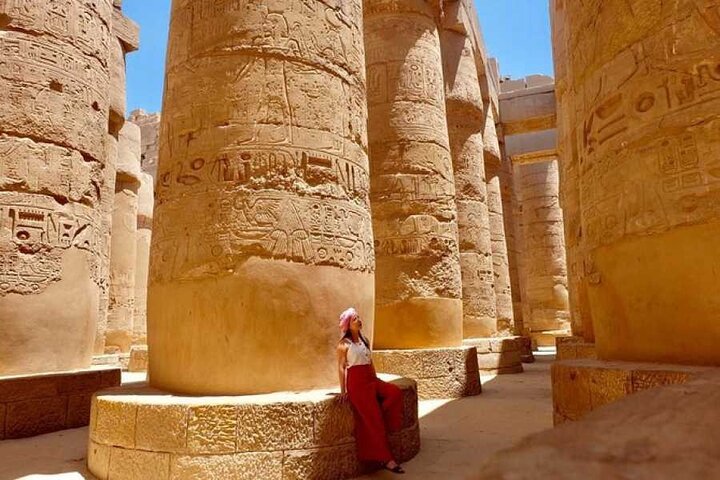Why choose this Cairo tour ?
Our exclusive and personalized Luxor Day Tour provides a seamless escape from the bustling streets of Cairo to the rich historical landscapes of Luxor. The tour includes visitations to the iconic Valley of the Kings, the Deir El Bahari Temple of Queen Hatshepsut, and the impressive Colossi of Memnon. Lastly, also included in this fascinating journey into Ancient Egypt are visits to the Luxor and Karnak Temples. Travel comfortably with a private guide that ensures a comprehensive understanding of the historical significance of each location, offering a truly enriching experience.
Make the most of your Cairo adventure
What makes Day Trip To Luxor From Cairo By Plane with Lunch a unique experience ?
Visiting the highlights of Luxor Starts at 3:30 am with Pickup from your hotel in Cairo by Our Representative and Transfer to the domestic airport to take your flight to Luxor.
Arrival Luxor, Our expert tour guide will greet you with a sign shows your name on it then you will be transferred by Private A/C Vehicle (Latest Model) to start your Full Day Tour to West Bank of Revier Nile Where you Visit Valley of Kings The Valley of the Kings (Arabic: وادي الملوك Wādī al-Mulūk; Coptic: ϫⲏⲙⲉ, romanized: džēme), also known as the Valley of the Gates of the Kings (Arabic: وادي ابواب الملوك Wādī Abwāb al-Mulūk),[2] is a valley in Egypt where, for a period of nearly 500 years from the 16th to 11th century BC, rock-cut tombs were excavated for the pharaohs and powerful nobles of the New Kingdom (the Eighteenth to the Twentieth Dynasties of Ancient Egypt).
The Mortuary Temple of Hatshepsut, also known as the Djeser-Djeseru (Ancient Egyptian: ḏsr ḏsrw “Holy of Holies”), is a mortuary temple of Ancient Egypt located in Upper Egypt. Built for the Eighteenth Dynasty pharaoh Hatshepsut, who died in 1458 BC, the temple is located beneath the cliffs at Deir el-Bahari on the west bank of the Nile near the Valley of the Kings. This mortuary temple is dedicated to Amun and Hatshepsut and is situated next to the mortuary temple of Mentuhotep II, which served both as an inspiration and, later, a quarry. It is considered one of the “incomparable monuments of ancient Egypt
The Colossi of Memnon (Arabic: el-Colossat or es-Salamat) are two massive stone statues of the Pharaoh Amenhotep III, who reigned in Egypt during the Eighteenth Dynasty of Egypt. Since 1350 BCE, they have stood in the Theban Necropolis, located west of the River Nile from the modern city of Luxor.
The Luxor Temple (Arabic: معبد الاقصر) is a large Ancient Egyptian temple complex located on the east bank of the Nile River in the city today known as Luxor (ancient Thebes) and was constructed approximately 1400 BCE. In the Egyptian language it is known as ipet resyt, “the southern sanctuary”. In Luxor there are several great temples on the east and west banks. Four of the major mortuary temples visited by early travelers include the Temple of Seti I at Gurnah, the Temple of Hatshepsut at Deir el Bahri, the Temple of Ramesses II (i.e., Ramesseum), and the Temple of Ramesses III at Medinet Habu. The two primary cults’ temples on the east bank are known as the Karnak and Luxor.[1] Unlike the other temples in Thebes, Luxor temple is not dedicated to a cult god or a deified version of the pharaoh in death. Instead, Luxor temple is dedicated to the rejuvenation of kingship; it may have been where many of the pharaohs of Egypt were crowned in reality or conceptually
The Karnak Temple Complex, commonly known as Karnak (/ˈkɑːr.næk/, from Arabic Khurnak meaning “fortified village”), comprises a vast mix of decayed temples, chapels, pylons, and other buildings near Luxor, in Egypt. Construction at the complex began during the reign of Senusret I in the Middle Kingdom (around 2000–1700 BC) and continued into the Ptolemaic period (305–30 BC), although most of the extant buildings date from the New Kingdom. The area around Karnak was the ancient Egyptian Ipet-isut (“The Most Selected of Places”) and the main place of worship of the Eighteenth Dynasty Theban Triad with the god Amun as its head. It is part of the monumental city of Thebes. The Karnak complex gives its name to the nearby, and partly surrounded, modern village of El-Karnak, 2.5 kilometres (1.6 miles) north of Luxor.
Transfer to the domestic airport to take your flight Back to Cairo. Arrival, meet & assist by our local representative then transfer to your hotel in Cairo
Tour Description & Additional Info:
- Public transportation options are available nearby
- Specialized infant seats are available
- Not recommended for travelers with spinal injuries
- Not recommended for pregnant travelers
- Not recommended for travelers with poor cardiovascular health
- Suitable for all physical fitness levels
- Note : To confirm your booking will need copy photo from your passport please update it with booking process
- Domestic flights from/to Cairo-Luxor (If option selected)
Options To Choose for Your Trip:
Day Trip To Luxor From Cairo By Plane with Lunch Inclusions:
Included with Your Ticket
- Hotel pickup and drop-off
- Professional guide
- Entry Fees
- Lunch
- Domestic flights from/to Cairo-Luxor (If option selected)
- Bottled water
Not Included
- Personal Items
- Entry fee to the tomb of king tut
Trending Cairo Nearby Tours Likely To Sell Out
Special Instructions:
- This Tour is Provided by Emo Tours Egypt.
- Tour Timezone & Starts at Africa/Cairo.
- Mobile or paper ticket accepted.
- All sales are final. No refund is available for cancellations.
- This Tour is Rated 1 Stars based on 7 valid reviews on VIATOR.
- Minimum 1 Travelers is required to book.
- Maximum 15 Travelers is accepted for booking.









